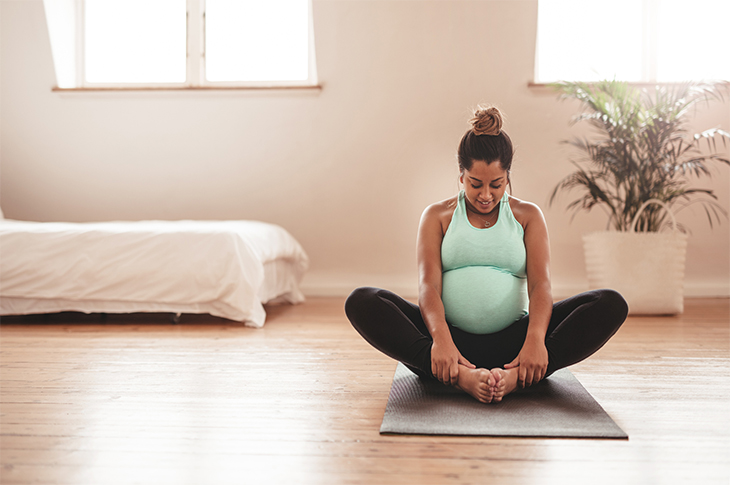
When you’re pregnant, especially for the first time, you’re full of questions. You want to be sure that you are keeping yourself and your growing baby safe. And suddenly you may wonder about what you’re eating, any supplements you’re taking, and how you’re working out.
Naturally, many moms-to-be turn to the internet. And that’s where things can become confusing. When it comes to exercising while pregnant, there’s a lot of contradictory information, in part because some of the guidance is outdated. To clear up the most common myths, we talked to pre- and postnatal experts. Keep in mind that it’s always best to consult your healthcare provider before engaging in physical activity.
Myth #1: If you haven’t worked out before, you shouldn’t start now
If you’ve never touched a barbell, now is not the time to start powerlifting. However, you can start something new, under proper guidance, says Juan Michelle Martin, DPT, a pelvic health physical therapist and pre- and postnatal expert.
“Your body is going through so many changes, especially at and around the pelvis, lower back, and hips,” she explains. These changes can cause a sense of hyper-mobility and instability, which can lead to aches and pains. Plus, your posture changes as your center of gravity is pulled forward, often leading to an arch in the lower back. “If we can maintain strength, it can help stabilize the joints and slow lower-back changes,” Martin says.
And there’s the fact that babies grow quickly. A one-year-old weighs an average of 17 to 28 pounds. “Factor in how much moms are lifting and carrying, and car seats weigh a ton, and you’re getting the stroller in and out of the car…being able to engage in some type of fitness activity really helps prepare the body for postpartum activity,” Martin says. It also may help with delivery and recovery after giving birth.
Myth #2: Do not let your heart rate go above 140 beats per minute (bpm)
According to the Journal of Sports Science & Medicine, “Due to the fact that the American College of Obstetricians and Gynecologists (ACOG)’s position on exercise during pregnancy was significantly more restrictive prior to 1994, it is possible that some obstetricians adhere to now obsolete recommendations that heart rate does not exceed 140 bpm and the duration of ‘strenuous’ exercise be limited to 15 minutes.”
The most recent guidelines from ACOG share that one way to test your exertion is to use the “talk test”. As long as you can carry on a conversation while you are exercising, you are likely not overexerting yourself.
You should feel comfortable and capable of working out at the heart rate you’re at. If not, back it down.
Myth #3: After the first trimester, you shouldn’t lie on your back
After about week 20 or earlier, if an expecting woman is on her back for a long time, it causes pressure on the vena cava. This is the main vein that carries blood back to the heart—and the fetus. If this happens, the woman may become dizzy or lightheaded. If you are not working with a certified trainer, it’s best to avoid supine exercises, Martin says. If, however, you are being supervised by a professional during your workouts and you are accustomed to these exercises, it may be OK.
But listen to your body. If you experience any symptoms, it’s probably best to avoid those exercises.
Myth #4: Any abdominal exercises will lead to diastasis recti
Diastasis recti happens when the right and left side of the abdominis rectus (the “six-pack” muscles) separate. Most women experience this—after all, the uterus is expanding to accommodate a growing baby, so the muscles are also going to make room. And many times, the condition goes away after a few months postpartum.
But even if it doesn’t, skipping core work while you’re pregnant is not the solution. “Core strength is very important during pregnancy, specifically around possibly decreasing [an arched lower back] as the baby grows,” says Farel Hruska, a pre- and post-natal fitness specialist and director of education and culture at Chuze Fitness.
She recommends incorporating a variety of core exercises such as cat-cows and, for some, planks. Only do planks if you can contract your abs. To test, come to all fours near a mirror. Try to contract your abs toward your spine. If you can visibly see the difference with your belly rising up toward your spine, try a plank and see if it feels OK to you. If you do not see your abs moving toward your spine, do not do planks.
Myth #5: Lifting weights is detrimental
“We want to be able to load the muscles,” Martin says. “If we work on strengthening, the muscles can play a bigger role in stabilizing the lower back, which can help prevent or manage pain that’s common there during pregnancy. This also creates stability in the joints where the ligaments have become little more lax, which bodes better for recovering postpartum,” she adds. While you likely won’t be using your max weight, using some weight is good. Just be sure you never strain while lifting.
Myth #6: Only do low-impact exercise
“If you were not a runner pre-pregnancy, this is where you would want to hold off on taking up that new hobby until you are postpartum and cleared to exercise,” says certified trainer Anna Victoria. “But if you were a runner pre-pregnancy, then you can continue running while pregnant, at a pace you are comfortable with.”
Myth #7: You should never twist
As long as they feel OK, are performed with control (no jerking!), don’t go too deep, and don’t cause you to hold your breath, twisting movements can be incorporated into a prenatal workout program. “Movement in the transverse plane (a.k.a. rotation) is a part of life, and twisting needs to be practiced with load in order to be strengthened for life and motherhood,” Hruska says. Anti-rotation movements are also great, since when you’re holding a child, you need to resist rotation most of the time, she adds.
Myth #8: Only gentle yoga is OK
If you regularly practice yoga, the intensity of your yoga during pregnancy will depend on your level of experience. Note that balance becomes more challenging as the baby grows and the hormone relaxin causes joints to loosen, Hruska says. So be especially mindful during balance poses (you can always practice near a wall or avoid them), and of course, adjust any poses as necessary based on the size of your belly and your energy levels.
Finally, consider working with a prenatal yoga teacher or taking classes labeled as being prenatal. If you do this online, double-check that the instructor is certified in prenatal yoga.
Myth #9: You can do whatever you want
“Yes, you can exercise while pregnant. But you want to make sure whatever you are doing is something that has been vetted and will not push you more than you need to. You should have no nausea, aches, or pains during exercise,” Martin says.
This information is for educational purposes only and is not intended as a substitute for medical diagnosis or treatment. You should not use this information to diagnose or treat a health problem or condition. Always check with your doctor before changing your diet, altering your sleep habits, taking supplements, or starting a new fitness routine.

If you have questions about a Fitbit tracker, product availability, or the status of your order, contact our Support Team or search the Fitbit Community for answers.
Please note: Comments are moderated and may not appear immediately after submission.